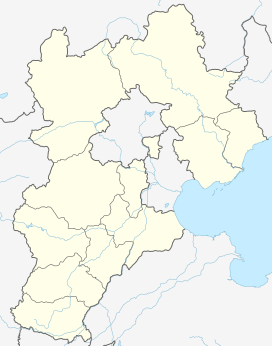Dingzhou
Dingzhou, or Tingchow in Postal Map Romanization, and formerly called Ding County or Dingxian, is a county-level city in the prefecture-level city of Baoding, Hebei Province. As of 2009, Dingzhou had a population of 1.2 million. Dingzhou has 3 subdistricts, 13 towns, 8 townships, and 1 ethnic township.[2] Dingzhou is about halfway between Baoding and Shijiazhuang, 196 kilometers (122 mi) southwest of Beijing, and 68 kilometers (42 mi) northeast of Shijiazhuang.
Dingzhou 定州市 | |
|---|---|
.jpg) Dingzhou skyline seen from Shuohuang Railway | |
 Location in Baoding | |
 Dingzhou Location in Hebei | |
| Coordinates: 38°30′58″N 114°59′24″E | |
| Country | People's Republic of China |
| Province | Hebei |
| Prefecture-level city | Baoding |
| Area | |
| • County-level city | 1,283.7 km2 (495.6 sq mi) |
| • Urban | 53.00 km2 (20.46 sq mi) |
| Elevation | 58 m (189 ft) |
| Population (2017) | |
| • County-level city | 1,249,000 |
| • Density | 970/km2 (2,500/sq mi) |
| • Urban | 414,000 |
| Time zone | UTC+8 (China Standard) |
| Postal code | 073000 |
| Area code(s) | 0312 |
| License Plate Prefix | 冀F |
| Website | www |
| Dingzhou | |||||||||
|---|---|---|---|---|---|---|---|---|---|
| Chinese | 定州 | ||||||||
| Postal | Tingchow | ||||||||
| Literal meaning | [Seat of] Ding ("Orderly") Prefecture | ||||||||
| |||||||||
| Former names | |||||||||
|---|---|---|---|---|---|---|---|---|---|
| Lunu | |||||||||
| Traditional Chinese | 廬奴 | ||||||||
| Simplified Chinese | 庐奴 | ||||||||
| |||||||||
| Boling | |||||||||
| Chinese | 博陵 | ||||||||
| |||||||||
| Dingxian | |||||||||
| Traditional Chinese | 定縣 | ||||||||
| Simplified Chinese | 定县 | ||||||||
| Postal | Tingsien | ||||||||
| |||||||||
History
Dingzhou was originally known as Lunu in early imperial China.[3] A tomb about 4 kilometers (2.5 mi) southwest of Dingzhou from 55 BCE was discovered and excavated in 1973. It contained several fragments of Han literature, including manuscripts of Confucius's Analects, the Taoist Wenzi, and the Six Secret Teachings, a military treatise.
Dingzhou took its present name around 400 CE when it became the seat of Ding Prefecture under the Northern Wei, displacing the earlier An Prefecture.[3] In the mid-6th century, its territory held 834,211 people living in 177,500 households.[3] Under the Sui, the seat of Boling Commandery at present-day Anping was renamed "Gaoyang". In 607, Dingzhou then became the eponymous seat of a new Boling commandery and retained that name and status under the Tang[4] until it returned to the name Dingzhou between 621 and 742 and again after 758.[3] Its territory held only 86,869 people in 25,637 households in 639 but recovered to 496,676 people in 78,090 households by 742.[3]
In 1055, under the Song, the city became the home of the 84-meter-tall (276 ft) Liaodi Pagoda, which is today China's tallest surviving pre-modern pagoda.
Under the early Republic, it was known as Dingxian (then romanized "Tingsien" or "Ting Hsien") from its status as the seat of Ding County. From 1926 to 1937, the county was the site of the National Association of Mass Education Movement's Ting Hsien Experiment of the Rural Reconstruction Movement. In the 1990s, the New Rural Reconstruction Movement maintained a training and outreach center.
Administrative divisions
[2] Towns:
- Qingfengdian (清风店镇), Dongting (东亭镇), Liqingu (李亲顾镇), Mingyuedian (明月店镇), Daxinzhuang (大辛庄镇), Xingyi (邢邑镇), Zhuanlu (砖路镇), Liuzao (留早镇), Pangcun (庞村镇), Gaopeng (高蓬镇), Ziwei (子位镇), Dingningdian (叮咛店镇), Dongwang (东旺镇), Kaiyuan (开元镇)
Townships:
- Dongliuchun Township (东留春乡), Zhoucun Township (周村乡), Daluzhuang Township (大鹿庄乡), Yangjiazhuang Township ({{lang|zh-hans|杨家庄乡], Zhaocun Township (赵村乡), Xicheng Township (西城乡), Xizhong Township (息塚乡), Haotouzhuang Hui Ethnic Township (号头庄回族乡)
Transportation
Dingzhou is one of the transportation hubs in North China.
Railroads
- Jingguang railway: Dingzhou Railway Station
- Jingshi Passenger Railway: Dingzhou East Railway Station
- Shuohuang Railway: Dingzhou South Railway Station
Highways
- Jingshi Expressway
- China National Highway 107
Places of interest
.jpg)
- Liaodi Pagoda: The tallest existing pre-modern Chinese pagoda
- Dingzhou Confucius Temple: A well-preserved Confucius temple in Hebei
See also
- Shengyou, a village in Dingzhou
References
Citations
- Ministry of Housing and Urban-Rural Development, ed. (2019). China Urban Construction Statistical Yearbook 2017. Beijing: China Statistics Press. p. 46. Retrieved 11 January 2020.
- 定州市-行政区网
- Xiong (2017), "Dingzhou".
- Xiong, Victor Cunrui (2017), "Boling", Historical Dictionary of Medieval China, Lanham: Rowman & Littlefield, p. 69, ISBN 9781442276154.
Bibliography
- Sidney D. Gamble, Foreword by Y.C. James Yen. Field work directed by Franklin Ching-han Lee. Ting Hsien, a North China Rural Community (New York: International Secretariat Institute of Pacific Relations, 1954; rpr Stanford University Press, 1968). xxv, 472p. 54009009. Sociological survey conducted in the 1920s and early 1930s.
External links
| Wikimedia Commons has media related to Dingzhou. |